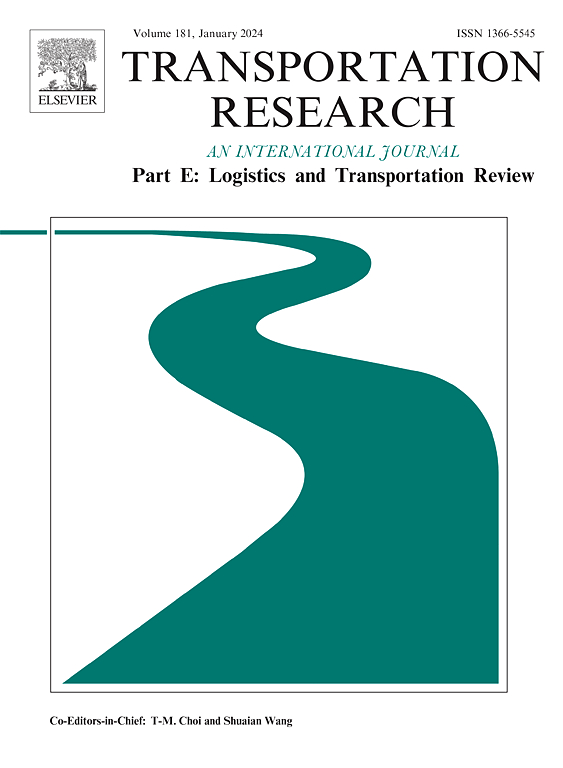中断高速铁路网的列车重新调度和旅客重新分配:一种分层弯曲分解和列生成方法
IF 8.3
1区 工程技术
Q1 ECONOMICS
Transportation Research Part E-Logistics and Transportation Review
Pub Date : 2025-05-17
DOI:10.1016/j.tre.2025.104177
引用次数: 0
摘要
交通中断可能导致部分关键交通系统无法使用,迫使列车和乘客都要适应。本研究针对高速铁路网在严重中断情况下的综合重新调度问题,著重于列车路线、时间表调整和乘客重新分配。我们采用重新调度策略,允许中断的列车通过车站内和整个网络的替代路径改变路线,利用剩余容量确保为受影响的乘客提供可靠的服务。为了解决这一问题,我们提出了一种基于详细时空网络的基于路径的混合整数线性规划(MILP)模型,旨在最大限度地减少列车延误和乘客因中断造成的不便。然而,随着问题规模的增加,使用列生成方法求解该集成模型会出现收敛性挑战。为了应对这些挑战,我们引入了一个包含两个主要组件的分层解决方案框架:(1)基于Benders分解的程序,用于迭代捕获列车重新调度和乘客重新分配之间的相互作用;(2)两个列生成程序,用于探索列车和乘客的有前途的时空路径。此外,还集成了一种动态约束生成技术,进一步加快了求解过程。利用中国高速铁路网实际数据进行的数值实验验证了该方法的有效性。结果表明,我们的方法在可接受的时间框架内提供了高质量的解决方案,在中断期间有效地重新分配乘客和改变列车路线。实验结果还表明,与顺序建模相比,集成建模的整体效率平均提高了17.32%。此外,本文提出的分层算法显著优于传统的列生成方法,平均减少计算时间53.82%。本文章由计算机程序翻译,如有差异,请以英文原文为准。
Integrated train rescheduling and passenger reassignment for disrupted high-speed railway networks: A hierarchical Benders decomposition and column generation approach
Disruptions can render parts of the critical transportation systems unavailable, forcing both trains and passengers to adapt. This study addresses the integrated rescheduling problem in a high-speed railway network during severe disruptions, focusing on train routing, timetable adjustments, and passenger reassignment. We employ rescheduling strategies that allow disrupted trains to reroute through alternative paths within stations and across the network, utilizing remaining capacity to ensure reliable service for affected passengers. To tackle this issue, we propose a path-based mixed-integer linear programming (MILP) model based on detailed space–time networks, aiming to minimize total train delays and passenger inconvenience caused by disruptions. However, solving this integrated model using the column generation method presents convergence challenges as the problem scale increases. To address these challenges, we introduce a hierarchical solution framework with two main components: (1) a Benders decomposition-based procedure to iteratively capture the interaction between train rescheduling and passenger reassignment, and (2) two column generation procedures to explore promising space–time paths for both trains and passengers. Additionally, a dynamic constraint generation technique is integrated to further accelerate the solution process. Numerical experiments using real-world data from Chinese high-speed railway network validate the effectiveness of the proposed approach. The results show that our method delivers high-quality solutions within an acceptable time frame, efficiently reassigning passengers and rerouting trains during disruptions. Experimental findings also reveal that integrated modeling improves overall efficiency by 17.32% on average compared to sequential modeling. Furthermore, the proposed hierarchical algorithm significantly outperforms traditional column generation methods, reducing computation time by an average of 53.82%.
求助全文
通过发布文献求助,成功后即可免费获取论文全文。
去求助
来源期刊
CiteScore
16.20
自引率
16.00%
发文量
285
审稿时长
62 days
期刊介绍:
Transportation Research Part E: Logistics and Transportation Review is a reputable journal that publishes high-quality articles covering a wide range of topics in the field of logistics and transportation research. The journal welcomes submissions on various subjects, including transport economics, transport infrastructure and investment appraisal, evaluation of public policies related to transportation, empirical and analytical studies of logistics management practices and performance, logistics and operations models, and logistics and supply chain management.
Part E aims to provide informative and well-researched articles that contribute to the understanding and advancement of the field. The content of the journal is complementary to other prestigious journals in transportation research, such as Transportation Research Part A: Policy and Practice, Part B: Methodological, Part C: Emerging Technologies, Part D: Transport and Environment, and Part F: Traffic Psychology and Behaviour. Together, these journals form a comprehensive and cohesive reference for current research in transportation science.

 求助内容:
求助内容: 应助结果提醒方式:
应助结果提醒方式:


